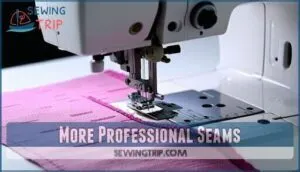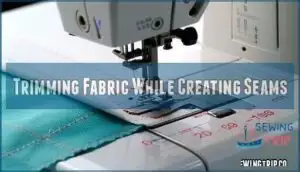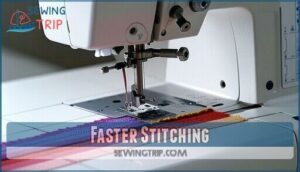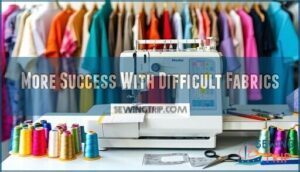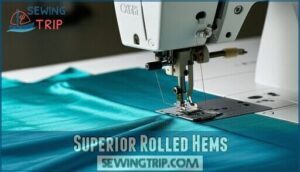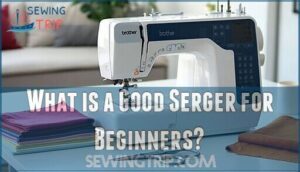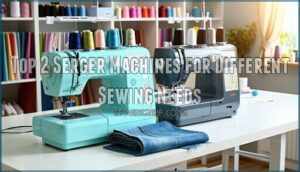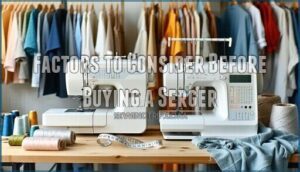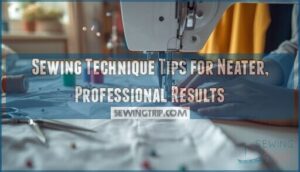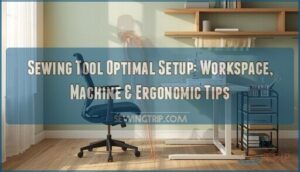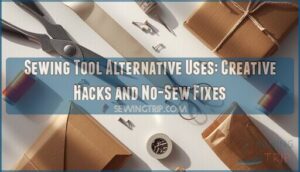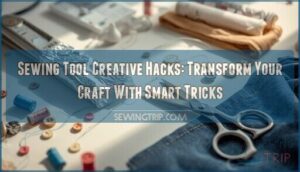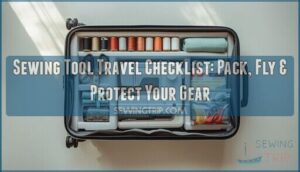This site is supported by our readers. We may earn a commission, at no cost to you, if you purchase through links.
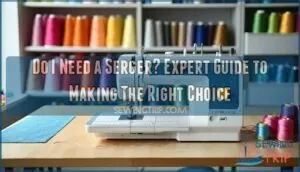
If you’re sewing mostly quilting cotton or home decor projects, your regular machine’s got you covered.
But if you find yourself muttering at stretchy fabrics that skip stitches or curl at the edges, a serger might just become your new best friend.
It’s like having a personal assistant that trims, sews, and finishes seams all at once – pretty neat trick, right?
The real question isn’t whether sergers are amazing, but whether your sewing style actually needs one, and if it can help with stretchy fabrics.
Table Of Contents
Key Takeaways
- You’ll benefit from a serger if you’re constantly working with knit fabrics – the differential feed system prevents stretching and creates professional-looking seams that won’t break when stretched.
- Skip the serger if you’re mainly sewing quilting cotton or home decor projects – your regular sewing machine handles woven fabrics just fine, and the investment won’t pay off for occasional use.
- A serger won’t replace your regular sewing machine – it can’t do buttonholes, zippers, or straight stitches, so you’ll need both machines for complete garment construction.
- Budget around $250-400 for a quality beginner serger – the Brother 1034D offers excellent value with color-coded threading guides that make learning manageable for newcomers.
What is a Serger and What Does It Do?
Instead of wrestling with fraying edges and wonky seams, you can let a serger sewing machine handle the heavy lifting.
This specialized overlock machine uses multiple threads—typically three to five—to create professional seam finishing that rivals store-bought clothing. The serger’s knife function trims excess fabric while simultaneously wrapping threads around raw edges, preventing fraying and creating stretchy seams perfect for knits.
What sets this sewing machine apart is its differential feed system, which prevents puckering on delicate fabrics and gathering on stretchy materials. Different overlock stitch types give you flexibility for various projects, from basic edge finishing to decorative rolled hems.
A serger’s differential feed system is the secret weapon that tames tricky fabrics effortlessly.
Sergers are also essential for achieving professional-looking finishes in homemade projects. However, serger limitations include inability to sew straight lines, create buttonholes, or handle tight curves.
Think of it as your sewing machine’s trusty sidekick—it excels at specific tasks but can’t replace your regular machine entirely.
Advantages of Having a Serger
You’ll quickly notice the difference a serger makes when you see your finished projects looking like they came straight from a store.
While your regular sewing machine handles construction beautifully, a serger takes your work to the next level with professional-quality seam finishes that won’t fray or fall apart after a few washes.
More Professional Seams
A serger sewing machine transforms your homemade garments into commercial-quality pieces that rival store-bought clothing.
Your overlock machine delivers superior seam durability through its multi-thread construction, making it perfect for knit fabrics that need stretch and strength.
- Enhanced longevity – prevents fraying and extends garment life
- Professional finishing – creates clean, polished seam finishing
- Faster production – combines cutting and sewing in one step
Trimming Fabric While Creating Seams
Beyond creating polished seams, your sewing serger becomes a precision trimming tool that revolutionizes garment construction.
With simultaneous trimming, you’ll slice away excess fabric while stitching—no more tedious pre-cutting! The adjustable width blade lets you control how much material gets removed, perfect for curved seams that demand finesse.
Modern overlock machines feature blade safety mechanisms, so you won’t accidentally nick your fingers. This sewing technique eliminates fabric waste by trimming only what’s necessary.
Watch your productivity soar as trimming becomes part of the stitching process, not a separate chore that doubles your project time, making it a garment construction process that is both efficient and safe, with simultaneous trimming.
Faster Stitching
When you’re cranking out multiple projects or running a small sewing business, speed matters.
A serger delivers faster stitching that’ll revolutionize your sewing productivity and transform how you tackle your project completion time.
Here’s how a serger boosts your sewing efficiency:
- Speed vs. Accuracy advantage – Sergers stitch up to 1,700 stitches per minute compared to 600 on regular sewing machines
- Production sewing benefits – Complete seams and edge finishing simultaneously
- Batch sewing efficiency – Process multiple garments without constant machine switching
- Time savings analysis shows 50% faster project completion on knit garments
- Enhanced sewing productivity – No more tedious zigzag finishing or pinking shears
Your serger becomes a productivity powerhouse for hemming, seaming, and finishing.
Whether you’re whipping up a dozen t-shirts or tackling holiday gifts, this sewing machine upgrade means less time wrestling with fabric and more time enjoying your finished creations.
More Success With Difficult Fabrics
Working with difficult fabrics like stretchy knits and slippery materials becomes a breeze when you’ve got a serger in your corner.
Your serger turns fabric nightmares into sewing victories.
The differential feed system keeps stretchy fabrics from getting stretched out of shape, while the cutting blade trims away excess fabric as you sew.
This means no more wrestling with jersey knits or chasing satin across your cutting table! Sergers are especially helpful when using a 4-thread mock stitch on knit fabrics.
| Fabric Challenge | Serger Solution |
|---|---|
| Knit Fabric Serging | Differential feed prevents stretching and puckering |
| Serging Slippery Fabrics | Cutting blade holds fabric steady while trimming |
| Thick Fabric Serging | Multiple threads create strong, flexible seams |
| Serging Pile Fabrics | Overlock stitch prevents fraying and maintains texture |
| Curve Serging Success | Smooth feeding system handles curves without bunching |
Superior Rolled Hems
Creating perfect rolled hems transforms your sewing game completely.
Your serger’s rolled hem feet and thread tension tips make Fine Fabric Hems effortless on silks and chiffons.
Curved Hem Mastery becomes second nature with practice on napkins and scarves.
Decorative Rolled Hems add professional flair that regular sewing machines can’t match, and this overlock feature alone justifies owning a serger for many sewists, providing a unique benefit with serger capabilities.
Who Doesn’t Need a Serger?
You mightn’t need a serger if budget limitations make it impractical right now. Simple projects like basic alterations, hemming pants, or making tote bags work perfectly fine with your regular sewing machine.
If you’re doing minimal sewing—maybe a few projects yearly—the investment doesn’t make sense. Limited space? Sergers aren’t exactly compact machines.
They need dedicated storage and workspace alongside your existing sewing machine. Many sewers get by beautifully using sewing patterns designed for regular machines.
Your trusty zigzag stitch handles fraying edges on woven fabrics reasonably well. For knits, a stretch stitch or twin needle creates flexible seams without breaking your budget.
Consider your actual sewing habits. Do you mainly tackle basic alterations or stick to simple sewing projects? A serger shines with frequent knit garments and high-volume sewing.
But if you’re hemming curtains or making occasional gifts, focus those dollars on quality fabric and helpful sewing tips instead.
What is a Good Serger for Beginners?
If you’re ready to add a serger to your sewing arsenal, the Brother 1034D stands out as the perfect beginner serger.
This Budget Friendly machine removes the intimidation factor with its color-coded threading guides that make Easy Threading a breeze – no more squinting at confusing diagrams!
The Learning Curve becomes manageable when you can actually see where each thread goes.
You’ll master basic Stitch Options quickly, from standard overlock seams perfect for sewing knits to rolled hems that’ll make your scarves look store-bought.
Don’t worry about this machine falling apart after a few projects – Durability Matters, and the Brother 1034D’s metal interior handles everything from lightweight jersey to heavy denim.
At around $275, it won’t break your budget like fancier models.
Considering its affordability, the Brother 1034D is a great low cost serger for both beginners and advanced sewists.
When comparing this sewing machine to standard options, you’ll notice the professional finish immediately.
Your homemade clothes will finally look like they belong in a boutique, not a craft fair.
Top 2 Serger Machines for Different Sewing Needs
If you’ve decided a serger would help your sewing projects, choosing the right model makes all the difference.
Here are two solid options that’ll handle most home sewing needs without breaking the bank.
Juki Portable Thread Serger Sewing Machine White
Juki’s threading system makes this serger a dream for beginners who want professional results without the headache.
- Machine Durability: Built like a tank, this overlock handles heavy fabrics effortlessly
- Stitch Quality: Delivers consistent, commercial-grade finishes at 1,500 stitches per minute
- Juki Portability: Compact design fits anywhere while maintaining industrial strength
The white aesthetics complement any sewing room, while color-coded guides eliminate threading confusion.
Its adjustable differential feed allows for handling stretchy materials with ease.
This sewing machine comparison winner excels at both delicate silks and tough denim, making it perfect for sewers ready to level up their craft.
Brother Serger Overlock Sewing Machine
While many Brother serger models shine in home sewing rooms, the Brother 1034D stands out as the ultimate beginner’s companion.
This overlock sewing machine delivers 1,300 stitches per minute with 22 built-in stitch options, making your projects fly by.
The color-coded threading system eliminates guesswork—no more wrestling with complicated paths.
Differential feed settings from 0.7 to 2.0 tame stretchy fabrics that usually misbehave.
When blade replacement time comes, the process won’t leave you scratching your head, and tension adjustment tips become second nature with this user-friendly design.
You can find Brother 1034D accessories to enhance its functionality.
In any sewing machine comparison, this Brother proves that professional results don’t require breaking the bank.
Factors to Consider Before Buying a Serger
Now that you’ve explored top serger options, it’s time to make the smart choice for your sewing journey. Buying a serger isn’t just about wanting one—it’s about matching your actual needs with the right investment.
Here’s what you should honestly assess before purchasing:
- Project Types: Are you constantly hemming knits or finishing garment seams? If you’re mainly quilting or doing basic repairs, hold off.
- Fabric Choices: Working with stretchy materials, delicate fabrics, or sewing for sale? A serger becomes your best friend.
- Budget Constraints: Quality sergers start around $250, but don’t cheap out—you’ll regret it when threads keep breaking. Considering the serger machine investment is essential for long-term use.
- Skill Level: Ready to learn threading techniques and overlocker maintenance? It’s not rocket science, but requires patience.
- Space Requirements: These machines need dedicated workspace and storage for multiple thread cones.
Your sewing machine handles precision work, while a serger tackles speed and professional finishes. Think of it as upgrading your toolkit, not replacing it.
Frequently Asked Questions (FAQs)
Do I need a serger machine?
Like choosing between a sports car and a pickup truck, you don’t need a serger, but it’ll transform your sewing experience.
You’ll get professional finishes and work faster with knits, but your regular machine handles most tasks fine, and having a serger is akin to having a luxury that enhances your sewing capabilities.
How to use a serger for practical applications?
Use your serger to finish raw edges, sew stretchy seams on knits, create rolled hems, and add professional touches to garments—it’s perfect for t-shirts, leggings, and home decor projects.
Do you need a serger if you want to sew?
No, you don’t need a serger to sew. It’s a specialized tool that complements your regular sewing machine but isn’t essential for most projects.
Do you need a serger machine to make clothes?
A serger isn’t like a hammer in every toolbox—it’s more specialized.
You can absolutely make clothes without one using your regular sewing machine, but you’ll spend extra time finishing edges and knit fabrics won’t behave as nicely.
Can you use a regular sewing machine as a serger?
A regular sewing machine can’t function as a serger – they’re completely different machines.
While you can use zigzag stitches or overlock presser feet to finish edges, you won’t get the same professional results or speed that a true serger provides.
What can I do instead of a serger?
Picture your grandma’s old wooden fence needing repair—you’d grab different tools for different jobs.
Instead of a serger, you can use zigzag stitches, pinking shears, or French seams to finish edges and prevent fraying effectively.
Can I use a serger without a regular sewing machine?
While you technically can use a serger alone, it’s like trying to cook with only a microwave—you’ll miss essential functions.
Sergers can’t do buttonholes, zippers, or straight stitches, so you’ll need both machines for complete projects.
How much does a decent serger typically cost?
Looking at current prices, a decent entry-level serger typically costs $200-
Quality brands like Juki or Brother offer reliable models in this range.
You’ll get professional finishes without breaking the bank completely.
Whats the learning curve like for serger beginners?
The learning curve’s manageable – you’ll master basic threading and stitching within a few practice sessions.
Threading takes patience initially, but modern sergers have color-coded guides.
Expect confidence after completing your first few projects, and note that patience is key to the learning process.
How often do sergers need professional maintenance or servicing?
Most home sergers need professional servicing every 1-2 years with moderate use. However, if you’re sewing frequently or notice tension issues, skipped stitches, or unusual noises, you’ll want maintenance sooner.
Conclusion
Ultimately, whether you need a serger depends on your sewing habits, fabric choices, and quality expectations.
You’ll love having one if you work with knits regularly, want professional-looking seams, or value time-saving features.
You can skip it if you’re happy with your current machine’s results and primarily sew stable fabrics. The key is honestly evaluating your sewing goals and whether a serger’s benefits align with your projects and budget.
- https://www.sewing.org/files/guidelines/2_150_serger.pdf
- https://weallsew.com/everything-you-wanted-to-know-about-sergers/
- https://publications.ca.uky.edu/files/fcs2802.pdf
- https://so-sew-easy.com/must-features-first-serger/
- https://www.sewcreativelounge.com/blogs/news/the-benefits-of-learning-to-serge-elevate-your-sewing-game

